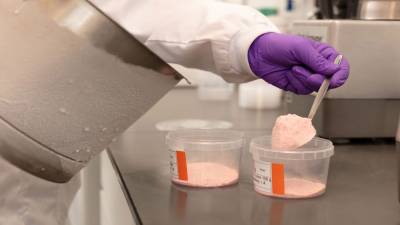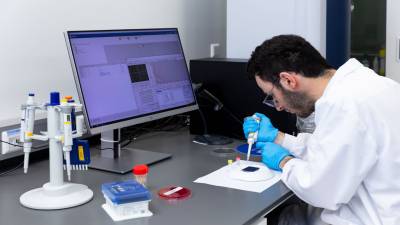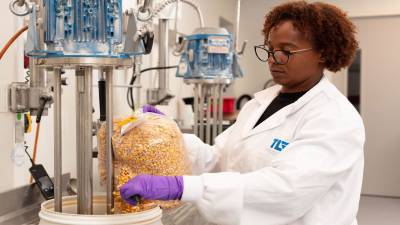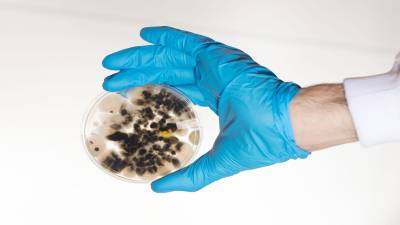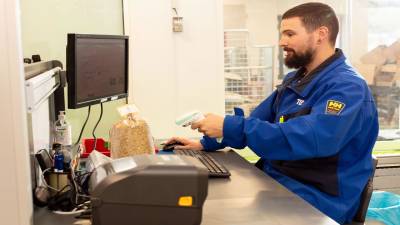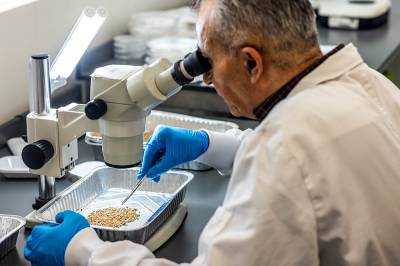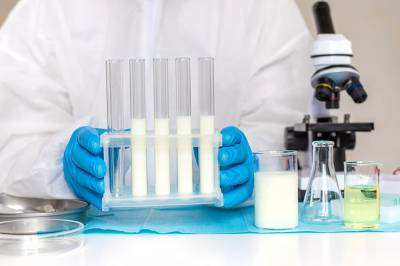Mycotoxins in Animal Feed
Risks, legislation and laboratory analysis.
Formation and persistence
Mycotoxins are toxic metabolites produced by moulds such as Fusarium, Aspergillus and Penicillium. They develop on feed materials such as grains and maize during cultivation or storage under warm, humid conditions. Due to their chemical stability, they remain intact during storage, transport and standard processing such as pelleting or extrusion.
Main mycotoxins in feed materials
Mycotoxin | Fungal genus | Feed matrices |
Aflatoxin B1 | Aspergillus spp. | Maize, peanuts, cottonseed meal |
Deoxynivalenol (DON) | Fusarium spp. | Wheat, maize, barley, by-products |
Zearalenone (ZEA) | Fusarium spp. | Maize, wheat, barley |
Fumonisins (B1, B2) | Fusarium spp. | Maize, maize gluten feed |
T-2 / HT-2 toxins | Fusarium spp. | Oats, barley, wheat |
Ochratoxin A (OTA) | Aspergillus, Penicillium spp. | Feed grains, feed meal |
Enniatins, Beauvericin | Fusarium spp. | Wheat, maize, barley |
Risks to animal health and supply chain integrity
- Livestock: reduced feed intake, growth retardation, reproductive disorders, immunosuppression
- Dairy cattle: reduced milk yield, aflatoxin B1 → aflatoxin M1 in milk
- Pigs: sensitive to DON (vomiting, feed refusal) and ZEA (hormonal effects)
- Poultry: reduced egg production, OTA accumulation in liver
Carry-over: Aflatoxin B1 and OTA can enter the human food chain via milk, eggs or meat products.
Co-contamination and climate change
- Co-contamination of multiple toxins in a single sample is common
- Interaction between DON, ZEA and fumonisins increases toxicological risk (synergism)
- Climate change is causing shifts in contamination pressure and mould distribution, including within storage chains
Legal framework and monitoring (feed)
- Directive 2002/32/EC
Maximum permitted levels for undesirable substances in animal feed, including aflatoxin B1, ZEA, DON and fumonisins - Recommendation 2006/576/EC
Monitoring of mycotoxin levels in feed materials; guidance values for Fusarium toxins - Recommendations 2012/154/EU and 2013/165/EU
Monitoring and evaluation of T-2/HT-2 and emerging mycotoxins - Regulation (EU) 2023/2782
Official analytical methods and sampling for feed control
Laboratory analysis at TLR
TLR analyses feed materials and animal feed ingredients for mycotoxins in accordance with ISO/IEC 17025 (RvA L059). All methods used are validated and aligned with legal requirements and customer specifications.
Matrix | Analytical method |
Maize, wheat, grains | LC-MS/MS screening, confirmation after cleanup |
Feed by-products | Multi-mycotoxin analysis (incl. DON, ZEA) |
Oils and high-fat feed materials | Targeted LC-MS for aflatoxins |
Compound feeds | Routine monitoring in accordance with GMP+ protocols |
Detection limits comply with the requirements of Directive 2002/32/EC and related recommendations. Reports include reference to the relevant limits, measurement uncertainty and accreditation details.
Feed chain and assurance
- GMP+ FSA
Mandatory for many producers and processors; includes risk-based monitoring of mycotoxins - SecureFeed
Supply chain assurance programme with specific requirements for sampling, analysis frequency and supplier assessment - Manure testing (indicative)
Traces of mycotoxins in manure may indicate prolonged exposure and carry-over risks
Conclusion
Mycotoxins in animal feed pose risks to animal health, production results and food safety. Through accredited analysis, supply chain-focused monitoring and compliance with legal frameworks, TLR supports producers and processors in managing these risks in a changing climate.
Meld je aan voor de laatste tips en adviezen dat je gelijk in de praktijk kunt brengen.


